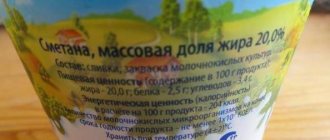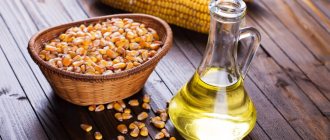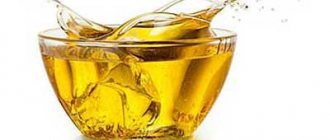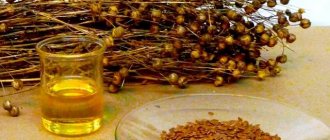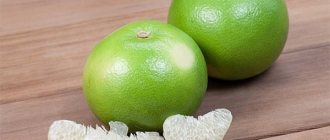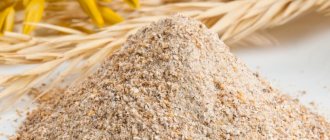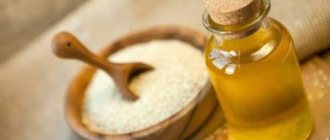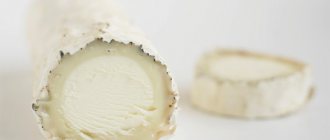Composition and nutritional value of peanut butter
Not every product can boast such a set of vitamins and microelements. Peanut butter contains the following:
- Omega-9 monounsaturated oleic acid (more than 40%);
- Polyunsaturated linoleic acid Omega-6 (about 30%);
- Saturated acids (17%);
- Fat-soluble vitamins A, D and E;
- The entire group of B vitamins;
- Ascorbic acid;
- Biotin, triolein;
- Sodium, potassium, magnesium, iron and zinc.
Nutritional value per 100 grams
The high nutritional value of the product is supported by the fat content - 53.8 g per 100 g of product. The composition contains proteins and carbohydrates - 7.5 g each. The raw materials contain natural sugars, salt and fiber. Peanut butter contains 889 calories.
A person's daily portion should not exceed 60 g. This figure corresponds to approximately 2 tablespoons. Regular consumption will allow you to replenish an adult’s daily fat requirement by 5%, protein – by 12%. A serving of peanut butter contains 132.6 calories.
What are the benefits and harms of peanut butter?
Peanut paste
Composition of the product
Vitamin
The vitamin composition of peanut treats is represented by the following components:
Minerals
The product boasts a range of different minerals:
Nutritional value and calorie content
The nutritional value of the product is represented by the following composition:
- teaspoon 12 g - 72 kcal;
- tablespoon - 210 kcal.
What are the benefits of peanut butter
Peanut delicacy is considered a balanced source of the most valuable components for human health.
Can I use it?
Peanuts are a strong allergen that can provoke severe allergic reactions, so people with allergies will have to avoid them.
Pregnant
Consumption of groundnut paste by pregnant women should be reduced to a minimum or eliminated altogether, as its potential harm may outweigh the beneficial effects. Among the risk factors, doctors identify:
Nursing
For children
Features of application and specific benefits
Groundnut paste is considered one of the important elements of a healthy diet. Surprisingly, with a fairly high calorie content, it is widely used in diets and sports nutrition.
How to choose
High-quality raw materials meet the following parameters:
- We evaluate the color. This indicator is influenced by various factors: harvest time, peanut maturity, presence of impurities. Unrefined oil will be red-brown, refined oil will be light yellow;
- The taste of the oil can be rich, pronounced, slightly bitter, sweet, salty and sour. Deviation from the standards is wateriness, sour or iron taste, bitterness. It is important that there is a pronounced nutty aroma;
- Attention to packaging. The Extra Virgin inscription is a guarantee of ideal quality. The Refined indicator will indicate that the product has been subject to refining. The Pomace label states that the product is second class. It is used in the food industry;
- Letters on the label. The abbreviation DOP indicates that the product was manufactured and bottled in one locality;
- Manufacturer. Six leading countries: USA, Germany, Canada, Australia, UK, South Africa;
- Correct container. It is best to store finished raw materials in a darkened glass bottle.
How to store
There are three things to consider when storing oil:
- Temperature. Before opening, it is optimal to keep the product at 20-24 degrees. The minimum permissible limit is 5 degrees. After the first use, it is recommended to place the bottle on the refrigerator door. The shelf life of raw materials will be 1 month;
- Storage. It is optimal to place the bottle in a dark closet on the bottom shelf away from heat sources. It is important to take into account the proximity of the product and keep the product away from spices and herbs;
- Ideal dishes. The best container is a darkened bottle. If the raw materials were purchased in tin or transparent glass, you should wrap the product in foil.
How to eat peanut butter
It is ideal to start a new day with a healthy nut product - it will be an excellent part of both sweet and salty breakfast, it will provide the body with carbohydrates and protein, activate the metabolism, and fill you up for a long time.
If you're going to a sports practice, also treat yourself to a healthy treat. It is suitable not only for “jocks”, but also for runners - increased consumption of proteins and minerals is necessary for all sports.
For athletes
What are the benefits of peanut butter for athletes, how to consume a healthy product? It is widely used in sports nutrition because... helps build muscle mass and increases the endurance of athletes. We are talking about a source of healthy fats, an alternative to animal sources of fat. You don't have to eat a kilogram of pasta in a week. 2-4 tsp is enough. in a day.
Pregnant
Eating nut products during pregnancy is a controversial issue. According to some experts, in the absence of allergies, we are talking about suitable foods while bearing a child. Nuts provide support for the proper development of the fetus and support the health of the expectant mother. But if adverse reactions of the body appear after consuming them, a stop is required - exclusion of nuts from the diet and consultation with a doctor.
Important! Consumption of nuts and products made from them during pregnancy (up to 4 tsp per day) by women who are not allergic to them can subsequently prevent allergic reactions in children.
When breastfeeding
Protein from peanuts passes into breast milk. But this does not mean there is a risk of allergies in the child. A study published in the Journal of Allergy and Clinical Immunology in 2008 found that in Israel, where nuts are a common part of the diet of breastfeeding mothers and children from 8 months of age, there were lower rates of nut allergies than their British counterparts. peers.
Start using ½-1 tsp, watch your and your child’s body’s reaction.
Beneficial features
The benefits of peanut butter are as follows:
- Reduces cholesterol levels and the risk of cardiovascular diseases. The content of “correct” lipids normalizes the amount of bad cholesterol. High-density lipoproteins are not deposited on the walls of blood vessels and relieve the load on the heart;
- Minimizes the likelihood of developing diabetes;
- Source of protein. Protein plays an important role in building muscle mass, which is why it is so necessary for children, young people, and athletes;
- Boosting immunity. Vitamin C supports the body's protective functions and stimulates cell renewal. Vitamin A is important for vision. Group B and vitamin E have a positive effect on the integument;
- Antioxidant properties. The complex of vitamins and microelements has a positive effect. Tissue cells begin to regenerate, which gives a rejuvenating effect;
- Anti-cancer properties are due to the content of plant phytosterol;
- Bean oil is an alternative to meat. The high amount of vegetable protein covers the body's daily requirement by almost 12%;
- Source of magnesium and potassium. The amount of magnesium in peanut butter covers the daily requirement by 45%. The microelement is involved in 300 metabolic processes in the body. And together with potassium, it has a positive effect on blood pressure.
Nutritionists classify peanut oil as a superfood. The beneficial properties of peanut oil are supported by a number of contraindications.
Harm to the body
In addition to the benefits, peanut butter can also cause harm to the body:
- Aflotoxin content. Peanuts are a plant that grows in the ground. Therefore, the fruits can carry fungal spores that are toxic to humans;
- Polyunsaturated acids in excess doses have a negative effect on the body. The amount of Omega-6 is about 30%. If you oversaturate your body with this substance, your health can worsen. For example, provoke the development of inflammation, increase the load on the heart or stimulate the work of the gall bladder;
- Peanut butter is high in calories. The product is characterized by the correct BJU. But fat predominates much more, which means it is important to clearly control the rate of product consumption;
- Nut allergy.
Experts recommend paying attention to the quality of the product. There is no need to increase the daily norm. And to be 100% sure of the authenticity of the product, you can prepare peanut butter at home.
Cooking at home
So how to make peanut butter at home? The recipe is quite simple. The beans are fried until golden brown and ground to a paste. In this form, the product is ready for use. You can add salt, honey, molasses for taste or any other substance to the base. If salt and sugar act as preservatives and extend the shelf life of the product. Then adding other components will significantly shorten the shelf life.
It is important to understand that the recipe involves making the peanut butter, not pressing it. This will be a fine mixture, which is very convenient to use. It is impossible to obtain pure oil at home. This requires special devices. But, what is the difference between peanut butter and butter? The first product is ready for use for both food and cosmetic purposes. The paste is more suitable for eating.
Beneficial properties and contraindications of peanut butter, how to take it so as not to cause harm
The leguminous grass, peanuts, is considered a major agricultural crop in the southern states of the United States.
Most of the country's harvest is used to produce peanut butter.
Americans cannot imagine their lives without her. How beneficial is paste for the human body? What is more in it, benefit or harm?
American breakfast
In the century before last, this plant from the legume family was called food for the poor.
Peanuts changed status at the beginning of the twentieth century.
In 1903, the American scientist George Carver came up with over 300 ways to use legumes in:
At the same time, a recipe for cooking peanut butter was invented, and it began its victorious march around the world.
Americans are considered to be fine connoisseurs and adherents of the product:
- every day it is put on the table of 40 million people in the United States.
The typical Yankee's most popular morning meal is a peanut butter and jelly sandwich.
What do you know about the beneficial properties and contraindications of kumiss? You can read which one has greater healing power, from mare’s or goat’s milk, after clicking on the link.
Read about the benefits of tan and ayran on this page.
Depending on the time of grinding peanuts and additives: candied fruits, coconut flakes, nuts (benefits and harm to the body), the paste has a different consistency and taste.
Some types of product are produced without salt and sugar, but the paste always retains its beneficial qualities and increased calorie content.
It is spread on toast and bread, washed down with coffee (the benefits and harms for pregnant women are written here), cocoa, milk or tea.
Chemical composition
The basic component of the paste is peeled, roasted and crushed peanuts, rich in proteins and vitamins.
Vegetable oil is added to it (what harm you can get from palm oil is written in this article), table salt and sugar. Peanut butter usually contains a stabilizer, which gives it a denser structure.
Thanks to cold processing, the paste does not lose the beneficial properties of legumes. The benefits of heat treatment are evidenced by the fact that properly roasted peanuts contain more polyphenols than freshly picked ones.
The high quality product has a uniform consistency with the aroma and taste of roasted peanut kernels.
The composition of the paste and the preparation technology affect its final color, which can be either light brown or thick coffee.
The energy value is 598 kcal per 100 grams. The lion's share comes from fats (455 kcal), followed by proteins (99 kcal), and carbohydrates (41 kcal) close the list.
The paste contains choline, vitamins D, E, K, C, PP and B vitamins (more than 81 mcg per 100 g). There is a high concentration of minerals here (in descending order):
In nutritional value, peanut butter is superior to all legumes, including peas and beans (white calorie content).
What do you know about the use of agar-agar? The advisability of using it for health purposes is described in a useful article.
You can read about the benefits and harms of starch jelly here.
What is the benefit
Healthy food
Peanut proteins replace animal proteins in the diet of vegetarians.
Dietary fiber counteracts constipation by restoring intestinal motility. This is also important for those who monitor their physical fitness and do not want to gain extra pounds.
Therapy and prevention
The paste has a wide range of healing capabilities. It strengthens the immune system, thanks to zinc, and fights sclerosis, relying on the help of linoleic acid, which lowers the threshold of bad cholesterol.
What dishes does it go with?
The nutty flavored oil is great for salad dressing. Since the product’s composition is similar to its sunflower and olive counterparts, it can easily be substituted in other dishes. To get maximum benefit from the product, you need to use raw materials correctly:
- Do not use for frying;
- Do not freeze;
- Eat the dish at room temperature.
This means that peanut butter is good only as a dressing and goes well with vegetable stews. The peanut butter flavor will also complement poultry and beef dishes. It is ideal to pour the dressing over baked mackerel.
Application in various fields
Peanut oil has found its wide application in many industries:
- In cooking, the oil is used as an additive to vegetable salads, meat and fish dishes. Not suitable for cooking;
- In cosmetology, I use peanut oil to restore hair and skin, prepare masks and scrubs. The product can be applied to hair as a nourishing base and rubbed into the scalp to stimulate growth. Ideal for combating dryness. The oil can be used for inflammatory processes, acne, dermatitis;
- In medicine, oil is used as a prophylactic. The main purpose of consuming raw materials is to prevent the development of cardiovascular and nervous diseases. The raw material is suitable for restoring the functioning of the kidneys, gall and liver. Peanuts have a positive effect on intestinal function.
How to take the product for preventive purposes? Nutritionists recommend drinking a tablespoon on an empty stomach in the morning or using it as an additive to foods. The oil is suitable for treating skin diseases.
Peanut bean oil is a unique product. This is a direct competitor to sunflower and olive analogues. The mildness of taste, medicinal properties and wide scope of application outperforms others. It is well absorbed and reduces the likelihood of developing many diseases. The product will be an excellent charger for the whole day. The main thing is not to overdo it with the daily dose and use it correctly in food.
How many grams of peanut butter are in a tablespoon?
1 level tablespoon holds 16 grams of peanut butter.
How many calories are in a spoon (teaspoon, tablespoon) of peanut butter?
There are 47 calories in 1 level teaspoon of peanut butter.
One level tablespoon of peanut butter contains 94 calories.
In conclusion to the article, it can be noted that knowing how many grams are in one teaspoon or tablespoon of peanut butter, you can easily measure the required amount to create your diet or when preparing any recipes. Please leave your feedback and useful tips on how to measure peanut butter with a spoon and how many calories are in a spoon of peanut butter in the comments to the article and share it on social networks if it was useful to you.
Did you like the article? Rate 5 stars:
( 1 ratings, average: 5.00 out of 5)
